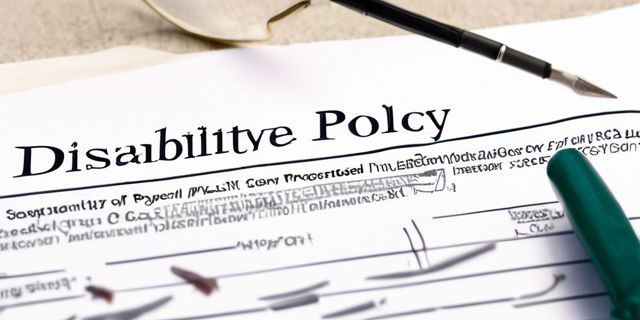The Best Short-Term Disability Insurance Policies to Protect Your Income 2024

Introduction
Have you ever thought about what would happen if you suddenly became unable to work due to an illness or injury? How would you pay your bills and maintain your standard of living? This is where short-term disability insurance comes into play. It’s a type of coverage that provides a portion of your income for a specified period, typically ranging from a few weeks to a year, should you become temporarily disabled and unable to work.
In today’s fast-paced world, where unexpected events can happen at any time, having a safety net like short-term disability insurance can be a lifesaver. It not only provides financial protection but also offers peace of mind, allowing you to focus on your recovery without worrying about mounting bills or depleting your savings.
What is Short-Term Disability Insurance?
Short-term disability insurance is a type of coverage that replaces a portion of your income if you become temporarily unable to work due to an illness, injury, or other qualifying condition. It’s designed to bridge the gap between the onset of your disability and your return to work or the start of long-term disability benefits, if applicable.
Here are some key features of short-term disability insurance:
- Benefit Period: The duration for which you can receive benefits, typically ranging from a few weeks to a year.
- Elimination Period: The waiting period before benefits kick in, usually between 7 and 30 days.
- Benefit Amount: The percentage of your income that the policy will pay, often ranging from 50% to 70%.
Short-term disability insurance can be obtained through your employer or purchased individually from private insurance companies.
Why is Short-Term Disability Insurance Important?

The importance of short-term disability insurance cannot be overstated. Here are some compelling reasons why you should consider this type of coverage:
- Financial Protection: A sudden disability can put a significant strain on your finances. Short-term disability insurance ensures that you have a steady stream of income during your recovery period, allowing you to maintain your standard of living and pay essential bills.
- Peace of Mind: Knowing that you have a safety net in place can provide invaluable peace of mind. You can focus on your recovery without the added stress of financial worries.
- Family Support: If you’re the primary breadwinner in your household, short-term disability insurance can help support your family financially during your temporary inability to work.
- Job Security: Some employers require employees to have short-term disability coverage as a condition of employment, ensuring that you can take the necessary time off without jeopardizing your job.
- Affordable Coverage: Short-term disability insurance is generally more affordable than long-term disability insurance, making it an accessible option for many individuals.
Factors to Consider When Choosing a Short-Term Disability Insurance Policy
When it comes to selecting the best short-term disability insurance policy, there are several factors to consider:
Benefit Amount
The benefit amount is the percentage of your income that the policy will pay out during your disability period. Typically, policies offer between 50% and 70% of your pre-disability income. It’s important to carefully evaluate your financial obligations and choose a benefit amount that will adequately cover your essential expenses.
Benefit Period
The benefit period is the maximum duration for which you can receive benefits. Most short-term disability policies offer coverage for a period ranging from a few weeks to a year. Consider your financial situation and the expected duration of your disability when selecting the appropriate benefit period.
Elimination Period
The elimination period, also known as the waiting period, is the number of days you must be disabled before benefits begin. Shorter elimination periods typically result in higher premiums, while longer elimination periods can lower your costs. Choose an elimination period that aligns with your emergency savings and ability to cover expenses during the waiting period.
Definition of Disability
Pay close attention to the policy’s definition of disability. Some policies cover disabilities that prevent you from performing your own occupation, while others have a stricter definition and only cover disabilities that prevent you from working in any occupation. Ensure that the definition aligns with your specific needs and circumstances.
Premiums and Affordability
While short-term disability insurance is generally more affordable than long-term disability coverage, premiums can vary significantly based on factors such as your age, occupation, and health status. Shop around and compare quotes from different insurers to find a policy that fits your budget while providing adequate coverage.
Portability
If you anticipate changing jobs or careers, consider a portable policy that you can take with you regardless of your employment status. This can provide continuity of coverage and prevent gaps in protection.
Exclusions and Limitations
Carefully review the policy’s exclusions and limitations to understand what conditions or circumstances may not be covered. Common exclusions include pre-existing conditions, self-inflicted injuries, and disabilities resulting from acts of war or illegal activities.
Reputation and Financial Strength of the Insurer
When choosing a short-term disability insurance provider, research the company’s reputation, financial stability, and claims-paying ability. Look for insurers with high ratings from independent agencies like A.M. Best or Standard & Poor’s.
Top Short-Term Disability Insurance Providers
To help you get started, here are some of the top short-term disability insurance providers to consider:
Mutual of Omaha
Mutual of Omaha is a well-known and respected insurance company that offers comprehensive short-term disability coverage. Their policies provide benefits for up to two years, with the option to choose a benefit period of 3, 6, 12, or 24 months. They also offer flexible elimination periods ranging from 0 to 180 days.
Guardian Life Insurance Company
Guardian Life Insurance Company is a reputable provider of short-term disability insurance. Their policies offer benefit periods of up to 26 weeks, with the option to choose a benefit amount of up to 60% of your pre-disability income. They also provide coverage for partial disabilities, allowing you to receive a portion of your benefits if you can work part-time.
Assurity Life Insurance Company
Assurity Life Insurance Company is a trusted name in the insurance industry, offering short-term disability policies with benefit periods of up to two years. They provide flexible elimination periods, ranging from 0 to 180 days, and offer coverage for both total and partial disabilities.
MetLife
MetLife is a leading provider of short-term disability insurance, offering comprehensive coverage with benefit periods of up to 53 weeks. Their policies include features such as rehabilitation incentives and partial disability benefits, making them a versatile option for various needs.
Aflac
Aflac is known for its supplemental insurance products, including short-term disability coverage. Their policies offer benefit periods of up to one year and provide flexible elimination periods to choose from. Aflac also offers the option to purchase additional riders for enhanced coverage.
How to Obtain Short-Term Disability Insurance
There are two primary ways to obtain short-term disability insurance:
- Employer-Sponsored Coverage: Many employers offer short-term disability insurance as part of their employee benefits package. This option is often more affordable and may be subsidized by your employer.
- Individual Policies: If your employer does not offer short-term disability coverage or if you are self-employed, you can purchase an individual policy from private insurance companies. This route allows you to customize the coverage to suit your specific needs and budget.
When obtaining short-term disability insurance through your employer, be sure to review the policy details carefully and understand the coverage limitations and exclusions. If purchasing an individual policy, shop around and compare quotes from multiple insurers to find the best fit for your circumstances.
Conclusion
In an unpredictable world where illnesses and injuries can strike at any time, having short-term disability insurance is a wise investment in your financial security and peace of mind. By carefully considering factors such as benefit amounts, benefit periods, elimination periods, and policy definitions, you can find the best short-term disability insurance policy that meets your needs and provides the protection you deserve.
Remember, protecting your income during a temporary disability is crucial for maintaining your standard of living and avoiding financial hardship. Don’t wait until it’s too late – explore your short-term disability insurance options today and safeguard your future.
FAQs
- How much does short-term disability insurance typically cost? The cost of short-term disability insurance can vary widely depending on factors such as your age, occupation, health status, and the coverage you choose. Generally, premiums range from 1% to 3% of your annual income.
- Can I receive both short-term and long-term disability benefits simultaneously? No, you cannot receive both short-term and long-term disability benefits at the same time. Short-term disability benefits are designed to provide coverage for a temporary period, while long-term disability benefits kick in after the short-term benefit period ends, provided you meet the policy’s definition of disability.
- What happens if I become disabled again after returning to work? Most short-
term disability policies have a provision called a “recurrent disability clause.” This clause allows you to resume receiving benefits without a new elimination period if you become disabled again from the same or a related condition within a specified timeframe (typically 6 months) after returning to work.
- Can I purchase short-term disability insurance if I’m self-employed? Yes, self-employed individuals can purchase individual short-term disability insurance policies from private insurers. This type of coverage can be especially valuable for those who rely on their ability to work to generate income and do not have access to employer-sponsored disability benefits.
- Do pre-existing conditions impact short-term disability insurance coverage? Pre-existing conditions can affect your ability to obtain short-term disability insurance or may result in exclusions for certain conditions. Insurance companies typically have a “look-back” period, which can range from several months to a year or more, during which pre-existing conditions may not be covered. It’s essential to disclose any pre-existing conditions accurately when applying for coverage.
External Sources
Here are some authoritative external sources used in this article:
- Mutual of Omaha: Short-Term Disability Insurance
- Guardian Life: Short-Term Disability Insurance
- Assurity: Short-Term Disability Insurance
- MetLife: Short-Term Disability Insurance
- Aflac: Short-Term Disability Insurance
- Nerdwallet: What Is Short-Term Disability Insurance?
- Policygenius: Best Short-Term Disability Insurance Companies
By utilizing these reputable sources, we aim to provide accurate and up-to-date information on short-term disability insurance policies and options.

